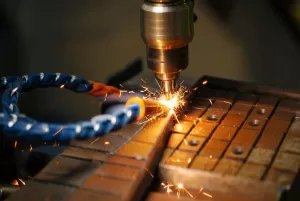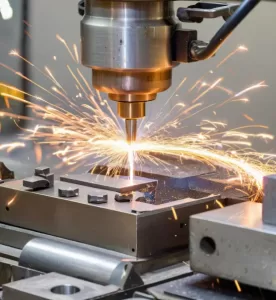March 8, 2025
What are the eight key points of high-precision processing of wire EDM?
Wire EDM: Achieving High Precision in Cutting
Wire EDM (Electrical Discharge Machining) is a non-contact method known for its high precision, as it uses wire diameters ranging from 0.05 mm to 0.3 mm. However, achieving ultra-precise results requires a deep understanding and meticulous attention to specialized techniques. Below, we explore the eight key points for high-precision wire-cutting, with an emphasis on optimizing the wire EDM process.
What is Wire Cutting?
Wire EDM involves using an electrically charged wire, typically made of brass, to melt and cut a workpiece. While brass is the most commonly used material, tungsten and molybdenum are also employed for ultra-precision applications. The wire never contacts the workpiece directly, which is one of the advantages of this process—enabling micron-level precision. Wire cutting is known for its ability to achieve exceptional accuracy (as low as 0.005 mm), similar to that of grinding, making it ideal for manufacturing progressive die parts, index rings, and gears.

Achieving high-precision wire EDM involves several critical factors. Below are eight essential considerations for improving the accuracy of wire-cut machining:
1. Increase the Number of Cutting Passes
Manufacturers often increase the number of processing passes to enhance surface finish. By making multiple cuts, you can smooth out any unevenness, resulting in a refined, polished surface. Each additional pass improves precision by removing any imperfections from the previous cuts.
2. Adjust Processing Conditions (Current Intensity)
Current intensity plays a significant role in wire EDM. A strong current is used for rough cutting, while a weak current is applied for finishing to improve surface quality. We typically machine products in 4-5 steps, sometimes repeating the process up to six times. The first rough pass may result in surface roughness (Ra) of about 10-20 μm, but after several finishing steps, we achieve a high-precision surface with roughness of just 1-5 μm.

3. Use of Fine Wire Electrodes
The diameter of the wire is crucial for high-precision cutting. We use wire electrodes ranging from 0.03 to 0.1 mm to improve accuracy, especially in R-section shapes. However, the thinner the wire, the more prone it is to breakage, which can slow down the processing speed. Balancing wire diameter with processing speed is key for optimal results.
4. Use of Tungsten Wire for Ultra-Precision
While brass wire is commonly used, tungsten wire is selected for ultra-precision machining due to its superior discharge characteristics and ability to produce finer surface finishes. However, tungsten wire is more expensive than brass, leading to higher machining costs. The investment in tungsten wire, though, can significantly enhance machining accuracy for high-precision applications.
5. Switch to Oil-Based Processing Fluids
Most wire EDM processes use water as the processing fluid, but oil is often preferred for high-precision work. Oil provides better insulation resistance than water, improving surface quality and machining accuracy. Although oil may present handling challenges and concerns about fire safety, it is the preferred choice when achieving superior surface properties is a priority.
6. Use High-Precision Wire Guides
To achieve optimal results in wire EDM, we slightly increase the wire tension and use high-precision wire guides. These guides clamp the upper and lower wires more precisely, ensuring accurate wire movement and enhancing the overall machining accuracy. This step is critical in achieving tight tolerances and high-quality results.
7. Adjustments for Different Wire EDM Machines
Machining accuracy can vary significantly between different WEDM machines. For instance, a Makino machine may require four passes, while a Shayuko machine might need five. As a result, we must adjust the wire-cutting conditions to optimize performance based on the machine manufacturer. Customizing the process for each machine is vital for achieving the desired precision.
8. Final Thoughts on Wire EDM Accuracy
For high-precision wire EDM, careful consideration of the machining steps is essential. While the machine specifications and materials used are important, the actual process of wire movement is what directly influences accuracy. Small decisions, such as whether to create starting holes, their sequence, or the number of starting holes, can significantly impact the final result. Rethinking the cutting process before programming is a critical step that can lead to remarkable improvements in wire EDM accuracy.
By refining each of these steps, manufacturers can enhance the precision and efficiency of their wire EDM processes, ensuring superior results in high-precision machining.